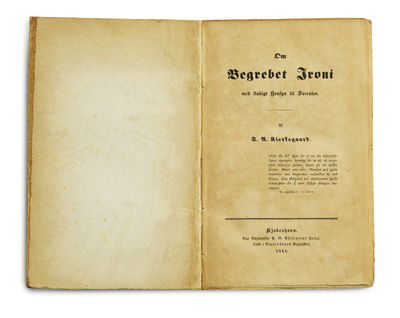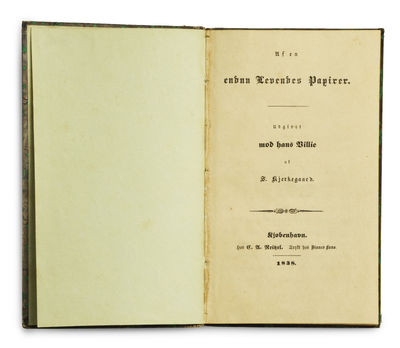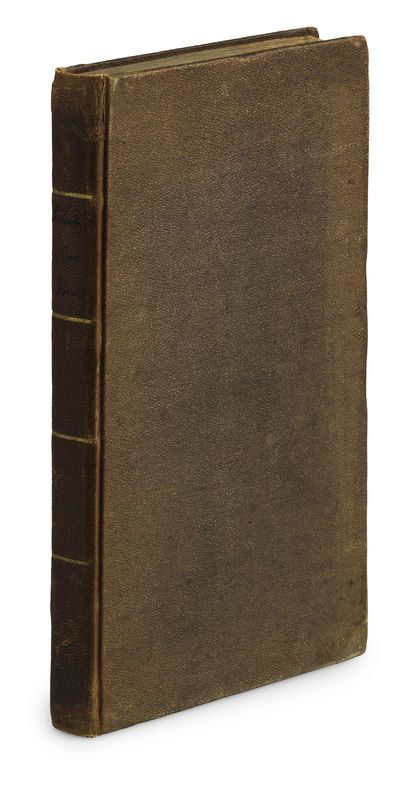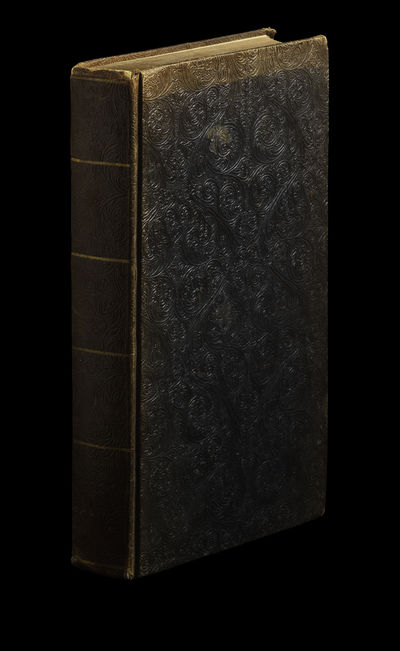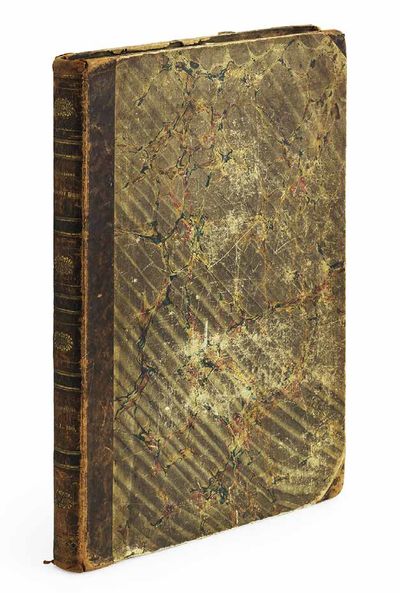KIERKEGAARD, SØREN.
Af en endnu Levendes Papirer. Udgivet mod hans Villie af S. Kjerkegaard. - [H.P. KIERKEGAARD'S COPY OF SØREN'S FIRST BOOK]
Herman H. J. Lynge & Søn A/S
lyn62105
Kjøbenhavn, C. A. Reitzel, 1838. 8vo. X, (2), 79 pp. Lovely contemporary brown half calf with marbled paper over boards. Double gilt lines and gilt lettering to spine. Foot of spine with the gilt initials of H.P. Kierkegaard. A few brown spots to the margin of the first eight leaves, otherwise remarkably clean. An excellent, beautifully preserved copy. With the ownership signature of H.P. Kierkegaard to front fly-leaf.
An exquisite copy of the first edition of Kierkegaard's first work, which has belonged to Kierkegaard's disabled cousin, who was a great source of inspiration to Kierkegaard. The relationship between the two cousins was very touching, and they both benefitted greatly from the other. Søren drew inspiration from his cousin, who was lame and unable to walk, and he cared a great deal for him. Hans Peter was one of the very few who had a standing invitation to visit Søren. He felt that his cousin might lead a truer and more meaningful life than most other people, who do not face the same hardships. Hans Peter, on the other hand, was greatly comforted by his famous cousin and his edifying writings. Søren helped him feel that, in spite of his hardships, his life was not wasted – he helped him believe in God. All copies of Kierkegaard's works belonging to his cousin denote a special significance, but it is especially lovely to find H.P. Kierkegaard's copy of his cousin's very first book. Kierkegaard's famous first work sews the seeds of his future career and initiates his philosophical production. It is in this famous review of Hans Christian Andersen as an author of novels, with a particular focus on his Only a Fiddler that Kierkegaard – the then 25 year-old theology student known only in a small academic circle, for his wit and sharp intelligence – puts forth his devastating criticism of Hans Christian Andersen – then 33 years old and already widely famous, Denmark's other national hero and world-famous fairy tale-author. Even though the book is written as a polemic review, we already here witness Kierkegaard's introduction of his emphasis on authentic individual existence will continue throughout his entire production; as thus, From the Papers of one Still Living serves as a highly important introduction to Kierkegaard's philosophical-ethical production. Kierkegaard points out that Hans Christian Andersen has not yet found himself and therefore cannot be a good author. This emphasis on authenticity and on the necessary first stage of the epic becomes an introduction to Kierkegaard's famous theory of stages that he develops in his later works. He rejects the notion that environment is decisive in determining the fate of genius – the genius is a shaping subject, not a passive one formed by circumstances. Not one that needs to be nurtured and sheltered in order not to perish. The work was originally meant to be published as an article in the literary periodical Perseus, of which Johan Ludvig Heiberg was the editor. But the article grew too extensive, and the intended columns in the periodical were given to H.L. Martensen instead. Martensen's article took up 70 pages and was about the idea of Faust, which vexed Kierkegaard, who had wanted to write about that subject himself. Kierkegaard, Hans Peter (1815-62) is always referred to as Kierkegaard's cousin, also by Kierkegaard himself, but if one is to be precise, he was Søren's half-cousin. H.P. was the son of M.P. Kierkegaard's (Søren's father) cousin, M.A. Kierkegaard. H.P. was one of the few people Kierkegaard was personally very close to. As Søren writes in a letter to H.P. (SKS letter no. 27) "you are one of the exceptions". He cared a great deal for his cousin, who was disabled. He was lame, completely paralyzed on one side of the body, and unable to walk. Intellectually, however, he was gifted, and the two cousins grew very close. Søren saw in him a purity that he did not see in other people, an ability to lead a truer and more meaningful life than others, who did not have to suffer in the same way. Søren was also a great comfort to H.P, who read the works of his famous cousin with enthusiasm. He probably owned every single work Kierkegaard wrote, and he drew great comfort from several of them. As Brøchner recalls in his recollections about Kierkegaard (Erindringer om Søren Kierkegaard – no. 43), H.P. "read his cousin's writings with the greatest of interest, occasionally visited him in his home, and drew much spiritual awakening from these visits." Brøchner continues to recall how he once told Kierkegaard what a great impression one of his works, Opbyggelige Taler i forskjellig Aand, had made upon H.P. In the confessional discourse, Søren portrays a person, who due to his bodily disposition is unable to practice anything physically or outwardly, and goes on to beautifully describe how this person too is subject to the same ethical demands as everyone else and what particular form this life-assignment takes on for him. To this, Søren replied "yes! To him, that work is a blessing". And so it was. Reading his cousin's upbuilding works provided the disabled Hans Peter with the power to overpower gloomy thoughts about his life having no meaning. Søren gave him, not only through his writings, but also through his meetings and conversations with him, the feeling of being as important as everyone else, as those who were physically blessed. There is no doubt that Kierkegaard drew inspiration from his admirable cousin, who had to overcome so much. And there is no doubt that H.P. was close to Søren's heart. Apart from Boeson, H.P. was the only person who had a standing invitation. He writes how he admires H.P., who, reconciled with his fate, with patience and devotion solves a task that is just as great as the one everyone else has to solve, whether they do big business, build houses, write great books, etc. – "when all is heard, everything, after all, mainly comes down to fervor – and when all is forgotten, it also comes down to fervor" … "Do not forget the duty to love thyself… That you are somehow set outside of life… that in the eyes of a stupid world, you are superfluous, let that not rob you of the idea of yourself." (Letter 27). Like his famous cousin, H.P. Kierkegaard was also a bibliophile and had a beautiful book collection. The books that surface from his library are usually in excellent condition and are often bound in beautiful bindings, much like those Søren had made for his books. Himmelstrup 6
An exquisite copy of the first edition of Kierkegaard's first work, which has belonged to Kierkegaard's disabled cousin, who was a great source of inspiration to Kierkegaard. The relationship between the two cousins was very touching, and they both benefitted greatly from the other. Søren drew inspiration from his cousin, who was lame and unable to walk, and he cared a great deal for him. Hans Peter was one of the very few who had a standing invitation to visit Søren. He felt that his cousin might lead a truer and more meaningful life than most other people, who do not face the same hardships. Hans Peter, on the other hand, was greatly comforted by his famous cousin and his edifying writings. Søren helped him feel that, in spite of his hardships, his life was not wasted – he helped him believe in God. All copies of Kierkegaard's works belonging to his cousin denote a special significance, but it is especially lovely to find H.P. Kierkegaard's copy of his cousin's very first book. Kierkegaard's famous first work sews the seeds of his future career and initiates his philosophical production. It is in this famous review of Hans Christian Andersen as an author of novels, with a particular focus on his Only a Fiddler that Kierkegaard – the then 25 year-old theology student known only in a small academic circle, for his wit and sharp intelligence – puts forth his devastating criticism of Hans Christian Andersen – then 33 years old and already widely famous, Denmark's other national hero and world-famous fairy tale-author. Even though the book is written as a polemic review, we already here witness Kierkegaard's introduction of his emphasis on authentic individual existence will continue throughout his entire production; as thus, From the Papers of one Still Living serves as a highly important introduction to Kierkegaard's philosophical-ethical production. Kierkegaard points out that Hans Christian Andersen has not yet found himself and therefore cannot be a good author. This emphasis on authenticity and on the necessary first stage of the epic becomes an introduction to Kierkegaard's famous theory of stages that he develops in his later works. He rejects the notion that environment is decisive in determining the fate of genius – the genius is a shaping subject, not a passive one formed by circumstances. Not one that needs to be nurtured and sheltered in order not to perish. The work was originally meant to be published as an article in the literary periodical Perseus, of which Johan Ludvig Heiberg was the editor. But the article grew too extensive, and the intended columns in the periodical were given to H.L. Martensen instead. Martensen's article took up 70 pages and was about the idea of Faust, which vexed Kierkegaard, who had wanted to write about that subject himself. Kierkegaard, Hans Peter (1815-62) is always referred to as Kierkegaard's cousin, also by Kierkegaard himself, but if one is to be precise, he was Søren's half-cousin. H.P. was the son of M.P. Kierkegaard's (Søren's father) cousin, M.A. Kierkegaard. H.P. was one of the few people Kierkegaard was personally very close to. As Søren writes in a letter to H.P. (SKS letter no. 27) "you are one of the exceptions". He cared a great deal for his cousin, who was disabled. He was lame, completely paralyzed on one side of the body, and unable to walk. Intellectually, however, he was gifted, and the two cousins grew very close. Søren saw in him a purity that he did not see in other people, an ability to lead a truer and more meaningful life than others, who did not have to suffer in the same way. Søren was also a great comfort to H.P, who read the works of his famous cousin with enthusiasm. He probably owned every single work Kierkegaard wrote, and he drew great comfort from several of them. As Brøchner recalls in his recollections about Kierkegaard (Erindringer om Søren Kierkegaard – no. 43), H.P. "read his cousin's writings with the greatest of interest, occasionally visited him in his home, and drew much spiritual awakening from these visits." Brøchner continues to recall how he once told Kierkegaard what a great impression one of his works, Opbyggelige Taler i forskjellig Aand, had made upon H.P. In the confessional discourse, Søren portrays a person, who due to his bodily disposition is unable to practice anything physically or outwardly, and goes on to beautifully describe how this person too is subject to the same ethical demands as everyone else and what particular form this life-assignment takes on for him. To this, Søren replied "yes! To him, that work is a blessing". And so it was. Reading his cousin's upbuilding works provided the disabled Hans Peter with the power to overpower gloomy thoughts about his life having no meaning. Søren gave him, not only through his writings, but also through his meetings and conversations with him, the feeling of being as important as everyone else, as those who were physically blessed. There is no doubt that Kierkegaard drew inspiration from his admirable cousin, who had to overcome so much. And there is no doubt that H.P. was close to Søren's heart. Apart from Boeson, H.P. was the only person who had a standing invitation. He writes how he admires H.P., who, reconciled with his fate, with patience and devotion solves a task that is just as great as the one everyone else has to solve, whether they do big business, build houses, write great books, etc. – "when all is heard, everything, after all, mainly comes down to fervor – and when all is forgotten, it also comes down to fervor" … "Do not forget the duty to love thyself… That you are somehow set outside of life… that in the eyes of a stupid world, you are superfluous, let that not rob you of the idea of yourself." (Letter 27). Like his famous cousin, H.P. Kierkegaard was also a bibliophile and had a beautiful book collection. The books that surface from his library are usually in excellent condition and are often bound in beautiful bindings, much like those Søren had made for his books. Himmelstrup 6
Adresse:
Silkegade 11
DK-1113 Copenhagen Denmark
Telefon:
CVR/VAT:
DK 16 89 50 16
Email:
Web:
![Af en endnu Levendes Papirer. Udgivet mod hans Villie af S. Kjerkegaard. - [H.P. KIERKEGAARD'S COPY OF SØREN'S FIRST BOOK] (photo 1)](https://d3525k1ryd2155.cloudfront.net/h/716/721/1703721716.1.l.jpg)
![Af en endnu Levendes Papirer. Udgivet mod hans Villie af S. Kjerkegaard. - [H.P. KIERKEGAARD'S COPY OF SØREN'S FIRST BOOK] (photo 2)](https://d3525k1ryd2155.cloudfront.net/h/716/721/1703721716.2.l.jpg)
![Af en endnu Levendes Papirer. Udgivet mod hans Villie af S. Kjerkegaard. - [H.P. KIERKEGAARD'S COPY OF SØREN'S FIRST BOOK] (photo 3)](https://d3525k1ryd2155.cloudfront.net/h/716/721/1703721716.3.l.jpg)
